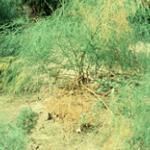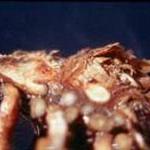Asparagus, Fusarium Crown and Root Rot
Fusarium oxysporum f.sp. asparagi
Fusarium proliferatum
Disease Description
Crown and root rot of asparagus, caused by two species of Fusarium (Fusarium oxysporum f.sp. asparagi and Fusarium proliferatum), is the most economically important disease of asparagus worldwide.
Identification:
Symptoms of Fusarium include a gradual decline in plant productivity and growth, stunting, yellowing, wilting, dry rot of the crowns, and plant death. Reddish-brown elliptical lesions often form on stems and the cortex; when stems are cut longitudinally, vascular discoloration can be seen. Most of the feeder roots are completely rotted and may have a reddish-brown discoloration.
Life Cycle:
The pathogens are ubiquitous and appear to be present in most field soils where it can survive indefinitely. The disease is spread by movement of infested soil and by contamination of seed. Infection occurs at any point below the ground and once inside the plant, the fungi invade the water conducting tissue. Fusarium populations in infested fields have been shown to decline to a base level after five years; however, the low levels persist for long periods. Adverse environmental factors such as poor drainage and poor cultural practices that increase plant stress predispose plants to disease.
Crop Injury:
Replanted fields exhibit both pre- and post-emergent blights.
Cultural Controls & Prevention:
- Treat seed with hot water or disinfectants to produce disease-free seedlings.
- Do not establish new plantings where asparagus has been grown within the past five years.
- Avoid excessive cutting periods which weaken the plant and reduce its ability to regenerate.
- Maintain plant vigor by proper fertilization and proper weed, Rust, and insect control.
- Plant tolerant varieties such as Jersey Giant, Apollo, Limburgia, and UC 157.
- Management of Fusarium crown and root rot is difficult; fungicide use is of little value.
Chemical Controls & Pesticides:
For Current information on disease recommendations ins specific crops including information on chemical control & pesticide management, please visit the New England Vegetable Management Guide website.
Insects that can vector or affect this disease:
Crops that are affected by this disease:
The Center for Agriculture, Food and the Environment and UMass Extension are equal opportunity providers and employers, United States Department of Agriculture cooperating. Contact your local Extension office for information on disability accommodations. Contact the State Center Director’s Office if you have concerns related to discrimination, 413-545-4800 or see ag.umass.edu/civil-rights-information.


